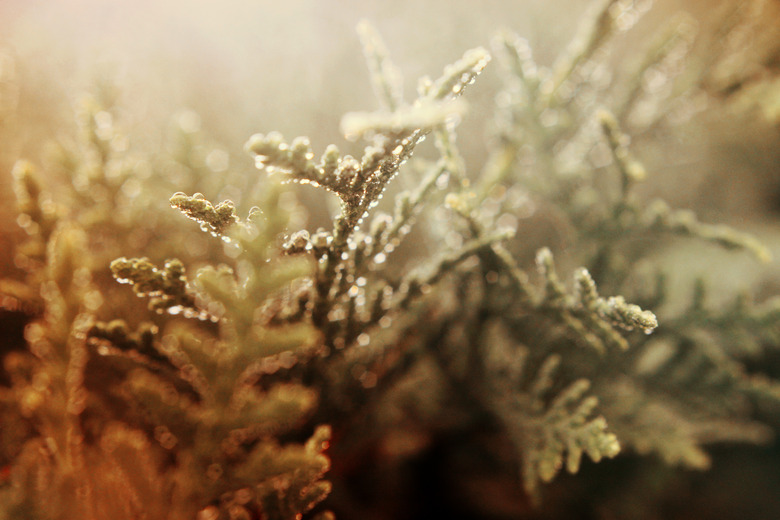What To Do If Thuja Occidentalis Trees Have Turned Brown
Although Thuja occidentalis (American arborvitae) naturally are dense, evergreen, pyramidal conifers, trees may turn brown in fall because of winter burn or in response to stress and infection. Growing 40 to 60 feet tall and 10 to 15 feet wide, American arborvitae trees are perennials in U.S. Department of Agriculture plant hardiness zones 2 through 7. Compact and dwarf cultivars are available, and trees tolerate annual pruning to restrict their size, making them useful hedging and screening plants. American arborvitae problems can usually be dealt with, making this an ideal plant even for those who don't have a lot of gardening experience.
Arborvitae Trees Turning Brown
Arborvitae Trees Turning Brown
American arborvitae trees turning brown in the colder regions of this plant's hardiness zone may simply be part of the plant's normal growth cycle, and often trees require no treatment. Although American arborvitae trees are evergreen, their inner branches turn brown and drop during fall and winter. Red-brown, mature bark sheds at the same time. American arborvitae's outer foliage may also turn yellow-brown, which may look unattractive, but the tree requires no treatment. Brush heavy snow buildup from branches to prevent breakage, and the trees' color will improve when new, fresh leaves appear in spring.
Harsh Conditions
Harsh Conditions
Protection from cold winds and drought prevents American arborvitae trees from turning brown. Strong, winter winds cause brown, burned leaves in American arborvitae growing in exposed sites, and the foliage also turns brown and dies during prolonged drought, which these trees don't tolerate. Prune away the damaged foliage from winter injury. If the entire branch is brown, scratch the bark on the affected branch and look for green underneath, which indicates the branch is still living and does not need to be removed.
Water your arborvitae well in a drought. If the foliage turns brown from drought, it may be too late to save it, so it's best just to prune away the dead foliage. Plant American arborvitae in sheltered, full-sun sites on moist, well-drained soil. Trees benefit from light afternoon shade in areas with hot summers and grow best on neutral or slightly alkaline soil. Water trees regularly so the soil remains moist but not sodden.
Leaf-Tip Blight
Leaf-Tip Blight
Leaf-tip blight turns American arborvitae leaf tips brown, and treatment involves pruning or spraying with fungicide. Symptoms of leaf-tip blight (Pestalotiopsis funerea) include tan or brown twig tips and small, black, pimple-like, spore-producing dots. Prune trees suffering from leaf-tip blight with pruning shears sterilized by wiping the blades with rubbing alcohol before making each cut. Prune all affected areas, cutting 3 inches from the affected area into healthy, living tissue, and sterilize the pruning shears again after use.
Alternatively, put on safety goggles and protective clothing, and spray foliage with a fungicide approved for arborvitae trees, following all manufacturer's instructions on the label. Repeat applications every seven to 14 days or as required. Spraying mature trees isn't feasible because of their great height, so consult your local cooperative extension service to inquire about alternative treatments offered by professional arborists. Fungicides should be stored out of reach of children and wash hands after using.
Twig Blights
Twig Blights
American arborvitae suffering from twig blights turn brown and require pruning. Kabatina twig blight (Kabatina thujae) infects 1-year-old American arborvitae branches, and phomopsis twig blight (Phomopsis juniperovora) can infect any branches. Infected tissue turns brown or ash gray as it dies, and dead branches remain on the tree for months. Small, black spots appear where dead tissue meets living wood. Prune American arborvitae suffering from twig blights with sterilized pruning shears, removing twigs and branches at least 3 inches inside healthy tissue. Bag and destroy all pruned branches. Fungicides to treat these twig blights aren't available for home use and can only be applied by professionals.
References
- Missouri Botanical Garden: Thuja Occidentalis
- Penn State Extension: Arborvitae Diseases
- Virginia Cooperative Extension: Eastern Arborvitae, American Arborvitae, White Cedar
- Ohio State University Extension: Arborvitae For the Home Landscape
- Wisconsin Horticulture: Winter Burn
- Do It Yourself: Six Mistakes to Avoid When Planting Arborvitae
